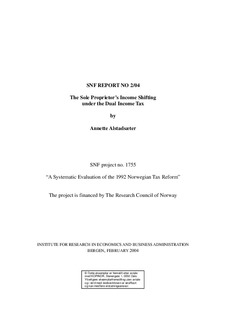| dc.contributor.author | Alstadsæter, Annette | |
| dc.date.accessioned | 2006-06-22T11:11:47Z | |
| dc.date.available | 2006-06-22T11:11:47Z | |
| dc.date.issued | 2004-02 | |
| dc.identifier.isbn | 82-491-0312-2 (trykt versjon) | |
| dc.identifier.issn | 0803-4036 | |
| dc.identifier.uri | http://hdl.handle.net/11250/165167 | |
| dc.description.abstract | The dual income tax provides the sole proprietor with large incentives to participate in tax minimizing income shifting to have more of his income taxed as capital income. The Norwegian split model is designed to remove these incentives, but it contains loopholes. The present paper concludes that the split model to some extent counteracts the negative effect of technology risk on the level of real capital in the sole proprietorship. But the split model also induces the sole proprietor to over-invest in less risky real capital. In addition, the widely held corporation serves as a tax shelter for the sole proprietor. The higher the business income and the higher the difference between the marginal tax rates on labour, the larger the incentives to incorporate. | en |
| dc.format.extent | 429033 bytes | |
| dc.format.mimetype | application/pdf | |
| dc.language.iso | eng | en |
| dc.publisher | SNF | en |
| dc.relation.ispartofseries | Report | en |
| dc.relation.ispartofseries | 2004:2 | en |
| dc.title | The sole proprietor’s income shifting under the dual income tax | en |
| dc.type | Research report | en |
